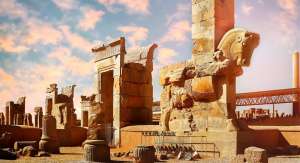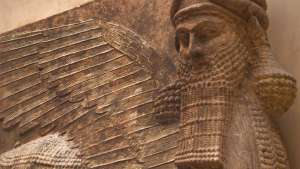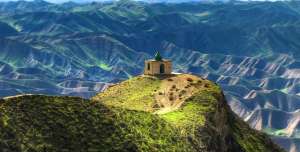Oman is a Muslim country and although it is quite modern and Westernised in some ways, in many others it is deeply traditional and conservative. Tourists are welcomed with open arms and a lot of hospitality and so is a great introduction for first time travellers to the Middle East. Much of the country’s interior falls within the sandy, treeless, and largely waterless region of the Arabian Peninsula known as the Rubʿ al-Khali.
Oman, officially the Sultanate of Oman, is a country on the southeastern coast of the Arabian Peninsula in Western Asia and the oldest independent state in the Arab world. Located in a strategically important position at the mouth of the Persian Gulf, the country shares land borders with the United Arab Emirates to the northwest, Saudi Arabia to the west, and Yemen to the southwest, and shares maritime borders with Iran and Pakistan. The coast is formed by the Arabian Sea on the southeast and the Gulf of Oman on the northeast. The Madha and Musandam exclaves are surrounded by the UAE on their land borders, with the Strait of Hormuz (which it shares with Iran) and the Gulf of Oman forming Musandam's coastal boundaries. Muscat is its capital and largest city.

Omani people
Omanis are the nationals of Oman. Omanis have inhabited the territory that is now Oman. In the eighteenth century, an alliance of traders and rulers transformed Muscat (Oman's capital) into the leading port of the Persian Gulf. Omani people are ethnically diverse; the Omani citizen population consists of many different ethnic groups. The majority of the population consists of Arabs, with many of these Arabs being Swahili language speakers and returnees from the Swahili Coast, particularly Zanzibar.
Additionally, there are ethnic Balochis, Lurs, Persians and Mehri. There are also Omanis from South Asia like the Lawatis and others. Moreover, in Dhofar, Sur and Muscat, people of Black African origin can be found. They are the descendants of the slaves who were brought from Africa centuries ago.
Omani citizens make up the majority of Oman's total population. Over one and a half million other Omanis live in other areas of the Middle East and the Swahili Coast.

Oman country
Much of the country’s interior falls within the sandy, treeless, and largely waterless region of the Arabian Peninsula known as the Rubʿ al-Khali. The region is still the domain of Bedouin nomads, although today it is also crisscrossed by oil and gas pipelines.
In contrast to the stark interior, the coastal regions are much more hospitable. Oman’s lush northern coast lies between the sea and inland mountains. This verdant, fertile region is known for its grapes and other produce, as is the Dhofar region in the country’s south. The capital, Muscat, lies along the northern coast. Blending modern and traditional architecture, the city commands a view of the Gulf of Oman and serves as a port and commercial centre.

Renowned in ancient times for its frankincense and metalworking, Oman occupies a strategically important location, for which it has long been a prize for empire builders. In the 16th century Muscat was seized by Portugal, which held the city until 1650. During the 18th century the Āl Bū Saʿīd dynasty expelled a Persian occupation and established Omani control over much of the Persian Gulf. The Āl Bū Saʿīd weathered much political turbulence but preserved its hold on power into the 21st century—largely by maintaining close relations with the United Kingdom—but the dynasty was slow to open the country to innovation. Significant modernization did not begin until after the coup in 1970 that brought Qaboos bin Said (Qābūs ibn Saʿīd) to power, at which point Oman rapidly began to develop an advanced economy. The once insular country now actively encourages tourism, and travelers come from afar to enjoy its hospitality and unspoiled landscapes.
Land
Slightly smaller in area than the country of Poland, Oman is bounded to the southwest by Yemen, to the south and east by the Arabian Sea, to the north by the Gulf of Oman, to the northwest by the United Arab Emirates, and to the west by Saudi Arabia. A small exclave, the Ruʾūs al-Jibāl (“the Mountaintops”), occupies the northern tip of the Musandam Peninsula at the Strait of Hormuz; this territory gives Oman its only frontage on the Persian Gulf. Its offshore territories include Maṣīrah Island to the east and Al-Ḥallāniyyah Island (the largest of the five Khuriyyā Muriyyā Islands) 25 miles (40 km) off the south coast.
Relief
Northern Oman is dominated by three physiographic zones. The long, narrow coastal plain known as Al-Bāṭinah stretches along the Gulf of Oman. The high, rugged Ḥajar Mountains extend southeastward, parallel to the gulf coast, from the Musandam Peninsula to a point near Cape al-Ḥadd at the easternmost tip of the Arabian Peninsula. Much of the range reaches elevations above 4,800 feet (1,463 metres); Mount Shams (“Sun Mountain”), at an elevation of 9,777 feet (2,980 metres), is the country’s highest point. The great central divide of Wadi Samāʾil separates the Ḥajar into a western and an eastern range. An inland plateau falls away to the southwest of the Ḥajar Mountains into the great Rubʿ al-Khali (“Empty Quarter”) desert, which the sultanate shares with Saudi Arabia and Yemen. These zones can be further subdivided into several unofficial regions: Al-Bāṭinah; the mountains and associated valleys of the Eastern Ḥajar and Western Ḥajar ranges; the Oman interior area, or Al-Jaww (the central foothills and valleys on the inland side of the Ḥajar Mountains and the historic heartland of Oman); Al-Ẓāhirah (the semidesert plain west of the interior Oman area, next to the United Arab Emirates, including Al-Buraymī oasis); Al-Sharqiyyah (sandy plains lying east of interior Oman behind the Ḥajar Mountains); and Jaʿlān (fronting the Arabian Sea south of Cape al-Ḥadd).
The southern region of Dhofar (Ẓufār) is separated from the rest of Oman by several hundred miles of open desert. Dhofar’s coastal plain is fertile alluvial soil, well watered by the southwest monsoon. Wooded mountain ranges, rising to about 5,000 feet (1,500 metres), form a crescent there behind a long, narrow coastal plain, on which the provincial capital of Ṣalālah is located. Behind the mountains, gravel plains gradually merge northward into the Rubʿ al-Khali.
Drainage
There are no permanent bodies of fresh water in the country. Intermittent streams are a product of seasonal storms and generally abate quickly. Some effort has been made in recent years to construct dams in an effort to preserve runoff and control flooding.
Climate
The climate is hot and dry in the interior and hot and humid along the coast. Summer temperatures in the capital of Muscat and other coastal locations often climb to 110 °F (43 °C), with high humidity; winters are mild, with lows averaging about 63 °F (17 °C). Temperatures are similar in the interior, although they are more moderate at higher elevations. Dhofar is dominated by the summer monsoon, making Ṣalālah’s climate more temperate than that of northern Oman. Rainfall throughout the country is minimal, averaging only about 4 inches (100 mm) per year, although precipitation in the mountains is heavier.
People
Ethnic groups
More than half of Oman’s population is Arab. However, large numbers of ethnic Baloch—who migrated to Oman from Iran and Pakistan over the past several centuries—live near the coast in Al-Bāṭinah. The Muscat-Maṭraḥ urban area has long been home to significant numbers of ethnic Persians and to merchants of South Asian ancestry, some of whom also live along Al-Bāṭinah. Notable among the latter are the Liwātiyyah, who originally came from Sindh (now in Pakistan) but have lived in Oman for centuries.

Several large Arab groups predominate along Dhofar’s coastal plain. The inhabitants of the Dhofar mountains are known as jibālīs, or “people of the mountains.” They are ethnically distinct from the coastal Arabs and are thought to be descendants of people from the Yemen highlands.
Languages
Arabic is the official language, and Modern Standard Arabic is taught in schools. In addition, a number of dialects of vernacular Arabic are spoken, some of which are similar to those spoken in other Persian Gulf states but many of which are not mutually intelligible with those of adjacent regions. The jibālīs, for example, speak older dialects of South Arabic. These differ greatly from most other dialects, which are derived from North Arabic (as is Modern Standard Arabic). English, Persian, and Urdu are also spoken, and there are a number of Swahili-speaking Omanis born in Zanzibar and elsewhere in East Africa who returned to Oman after 1970. Various South Asian languages are also spoken.
Religion
The overwhelming majority of Omanis are Muslims. The Ibāḍī branch of Islam, a moderate Khārijite group, claims the most adherents. In belief and ritual, Ibāḍism is close to Sunni Islam (the major branch of Islam), differing in its emphasis on an elected, rather than a hereditary, imam as the spiritual and temporal leader of the Ibāḍī community. Non-Ibāḍī Arabs and the Baloch are mostly Sunnis. Those in the South Asian communities are mainly Shīʿite, although a few are Hindus.

Economy of Oman
Oman is a rural, agricultural country, and fishing and overseas trading are important to the coastal populations. Oil in commercial quantities was discovered in Oman in 1964 and was first exported in 1967. Subsequently the production and export of petroleum rapidly came to dominate the country’s economy. Oil revenues represent roughly two-fifths of gross domestic product (GDP) and about three-fourths of the government’s income.
In anticipation of the eventual depletion of oil reserves, the government in 1996 initiated a plan for the post-oil era that focused on developing the country’s natural gas resources to fuel domestic industry and for export in the form of liquefied natural gas (LNG). Oman also sought to diversify and privatize its economy in addition to implementing its policy of Omanization of the workforce. By the end of the 1990s, the privatization plan had advanced further than those in the other states of the Gulf Cooperation Council (GCC)—Kuwait, Qatar, Saudi Arabia, Bahrain, and the United Arab Emirates. Notable features of the program included expanding the country’s stock market, selling several government-owned companies, and creating a more liberal investment environment. The country’s development has been aided in part by the GCC.
Transportation and telecommunication
Oman has several ports, most notably Port Qaboos in Maṭraḥ, Ṣalālah (formerly known as Port Raysūt), and Al-Faḥl, all of which were built after 1970; in the late 1990s work was begun to upgrade and expand the industrial port at Ṣuḥār. Ṣalālah underwent major renovations and in 1998 opened as one of the world’s largest container terminals; the port is considered by international shippers to be the preferred off-loading site in the Persian Gulf. Significant intercoastal trade is carried on by traditional wooden dhows. The two principal airports are located at Al-Sīb, about 19 miles (30 km) from Muscat, and at Ṣalālah. Oman Air serves as the government’s flagship airline and operates both domestically and internationally. Since 1970 a modern network of asphalt and gravel roads has been built up from virtually nothing to link all the country’s main settlements; about one-fourth of this network is paved. The country has no railroads, though plans have been underway since 2008 to build a nationwide rail network slated to connect to a regional rail network among GCC member states.
Government-owned Omantel (formerly known as General Telecommunications Organization) is Oman’s primary telecommunications provider. During the 1990s it instituted plans that increased the number of phone lines, expanded the fibre-optic network, and introduced digital technology. The Internet became available in 1997, with Omantel as the official provider. The use of cell phones increased dramatically after Omantel lost its monopoly on the mobile phone market in 2004. Satellite links provide much of the country’s international communications.










